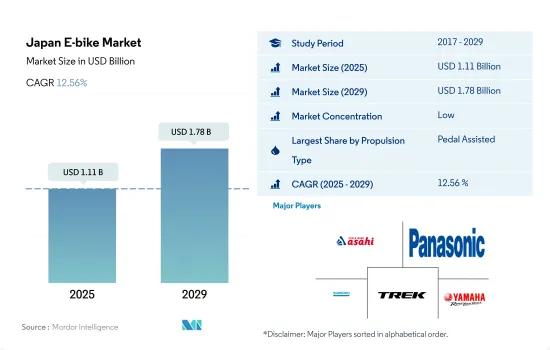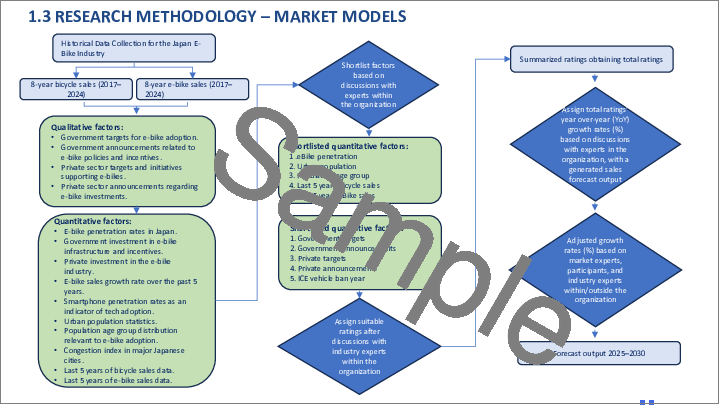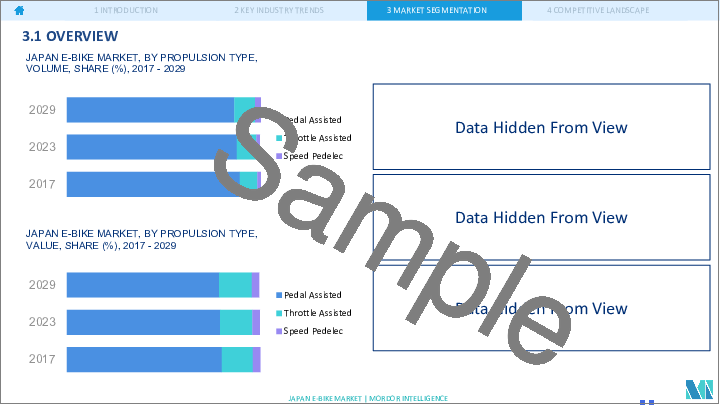|
|
市場調査レポート
商品コード
1683542
日本の電動自転車:市場シェア分析、産業動向・統計、成長予測(2025年~2029年)Japan E-bike - Market Share Analysis, Industry Trends & Statistics, Growth Forecasts (2025 - 2029) |
||||||
カスタマイズ可能
適宜更新あり
|
|||||||
価格
| 日本の電動自転車:市場シェア分析、産業動向・統計、成長予測(2025年~2029年) |
|
出版日: 2025年03月18日
発行: Mordor Intelligence
ページ情報: 英文 181 Pages
納期: 2~3営業日
|
全表示
- 概要
- 目次
概要
日本の電動自転車市場規模は2025年に11億1,000万米ドルと推定され、2029年には17億8,000万米ドルに達すると予測され、予測期間(2025-2029年)のCAGRは12.56%で成長すると予測されます。

推進セグメント市場の概要
- 日本は電動自転車に馴染みのあるアジアの国です。電動アシスト自転車は日本市場に導入され、自転車での日常生活に必要な体力が少なくて済むため、高齢者の助けとなりました。ペデレックのような電動アシスト自転車の基本的な利点は、用事や通勤など日常生活での使い勝手の良さにあります。日本のペデレック所有者の大半は、坂道の多い住宅地に住んでいるため、ペダルアシスト電動アシスト自転車を購入しました。
- 日本の道路網は、その起伏に富んだ地域性から、総延長128万kmを超え、何百もの橋やトンネルで構成されています。日本には交通量の少ない高速道路が非常に多いため、長距離サイクリングは日本全国で非常に一般的です。2021年には、日本の自転車新車販売台数の約12.2%を占めるペダル付き電動アシスト自転車(ペデレック)の価格は、通常7~15万円になると予想されます。
- 日本では、原動機付自転車を使用するイベントの数は、2011年の約2万3,140件から2020年には7,000件未満に減少しています。道路を走る自転車の数が増えれば、事故の可能性は低くなります。上り坂でのサイクリングなどのスポーツに対する若者の関心の高まりや、健康的で活動的なライフスタイルに対する意識の高まりが、今後の市場需要を後押しすると予想されます。ペダルアシスト自転車は短距離走行に便利だが、近い将来、スピードペデレックが最も便利な選択肢になると思われます。さらに、パワーとスピード性能が向上するにつれて、消費者は今後数年間、スピードペデレック・カテゴリーに引き寄せられる可能性が高いです。
日本の電動自転車市場動向
日本では電動自転車の普及率が一貫して上昇しており、これは市場の浸透と消費者の受容の拡大を反映しています。
- 日本の電動自転車市場は急速に都市部で最も人気のある交通手段になりつつあります。電動自転車は機動性に優れ、車両が減速するような障害物も容易にかわすことができるため、自動車よりも機敏で素早いです。
- 近年、日本で販売されるE-BIKEの台数は増加しており、高齢者や小さな子供を持つ共働き親からの需要が高まっています。電動アシスト自転車が日本市場に導入された当初は、高齢者が主要なターゲット層でした。通勤にはペダル付き自転車などの電動アシスト自転車が便利です。高齢者にとっては、少ない体力で日常生活が送れるというメリットがあります。しかし近年は、未就学児を持つ保護者が保育園に子どもを預ける際に、便利な電動自転車を利用するケースが増えています。
- 営業活動の再開と、封鎖期間中に課された貿易規制の解除により、日本では電動自転車の導入が増加しました。貿易規制の解除は、日本の輸出入活動に恩恵をもたらしました。燃費の良さや時間の節約といった電動自転車の特徴や利点により、日本における電動自転車の普及率は今後も上昇すると予測されます。
日本では、毎日5~15kmの距離を移動する通勤者の割合が高く、この移動距離に対する嗜好が強いことを示しています。
- 自転車文化は国内で人気を博しています。ここ数年、日本の自転車需要は増加しています。学校、マーケットプレース、就職先など、さまざまな場所への通勤に自転車を利用する人が増えています。2020年には、5~15kmの距離を運動したり、市場やオフィスなど近くの場所に行ったりするために自転車を利用する人が増えます。そのため、日本の自転車需要は2019年に比べて2020年に増加しました。
- パンデミック時に課された制限や障壁は、日本の自転車市場に大きく好影響を与えました。短距離の移動では、他の自動車を使う代わりに徒歩や自転車を選ぶ日本人が増えています。また、より高機能でバッテリー寿命の長い電動自転車が入手可能になったことも、週末の活動や運動に自転車を選ぶ個人を後押しし、2020年と比較して2021年には5~15kmの距離を自転車で移動する日本の通勤者数をさらに押し上げました。
- 近場への通勤に自転車を利用する習慣が定着したため、短距離の移動に自転車を利用することが一般的になりました。現在、多くの人が毎日、地元の市場や職場まで5~15kmの距離を自転車で通勤しています。健康上の利点の増大、二酸化炭素を排出しない通勤、交通渋滞を避けて時間を節約できることなどから、自転車通勤を好む人が増えています。これらの要因により、予測期間中、日本では5~15kmの距離を通勤する人の数が増加すると予想されます。
日本の電動自転車産業概要
日本の電動自転車市場は細分化されており、上位5社で37.20%を占めています。この市場の主要企業は以下の通りです。 Asahi Cycle, Panasonic Cycle Technology, Shimano Inc., Trek Bicycle Corporation and Yamaha Bicycles(sorted alphabetically).
その他の特典
- エクセル形式の市場予測(ME)シート
- 3ヶ月間のアナリストサポート
目次
第1章 エグゼクティブサマリーと主な調査結果
第2章 レポートのオファー
第3章 イントロダクション
- 調査の前提条件と市場定義
- 調査範囲
- 調査手法
第4章 主要産業動向
- 自転車販売台数
- 一人当たりGDP
- インフレ率
- 電子自転車の普及率
- 1日の移動距離が5~15キロの人口/通勤者の割合
- レンタサイクル
- 電動自転車バッテリー価格
- バッテリー化学の価格表
- 超ローカル配送
- 自転車専用レーン
- トレッカー数
- バッテリー充電能力
- 交通渋滞指数
- 規制の枠組み
- バリューチェーンと流通チャネル分析
第5章 市場セグメンテーション
- 推進タイプ
- ペダルアシスト
- スピードペデレック
- スロットルアシスト
- 用途タイプ
- 貨物/ユーティリティ
- シティ/アーバン
- トレッキング
- バッテリータイプ
- 鉛バッテリー
- リチウムイオンバッテリー
- その他
第6章 競合情勢
- 主要な戦略動向
- 市場シェア分析
- 企業情勢
- 企業プロファイル
- Asahi Cycle Co. Ltd
- Bridgestone Cycle Co. Ltd
- Fujikom Co. Ltd
- Giant Manufacturing Co. Ltd.
- Kawasaki Motors Corporation Japan
- Maxon Motor AG
- Panasonic Cycle Technology Co. Ltd
- Shimano Inc.
- Trek Bicycle Corporation
- Yamaha Bicycles
第7章 CEOへの主な戦略的質問
第8章 付録
- 世界概要
- 概要
- ファイブフォース分析フレームワーク
- 世界のバリューチェーン分析
- 市場力学(DROs)
- 情報源と参考文献
- 図表一覧
- 主要洞察
- データパック
- 用語集
目次
Product Code: 92156
The Japan E-bike Market size is estimated at 1.11 billion USD in 2025, and is expected to reach 1.78 billion USD by 2029, growing at a CAGR of 12.56% during the forecast period (2025-2029).

PROPULSION SEGMENT MARKET OVERVIEW
- Japan is an Asian country that is no stranger to electric bikes. Electric power-assisted bicycles were introduced to the Japanese market, aiding the elderly by requiring less physical strength to navigate their daily life on a bicycle. The fundamental advantage of motorized bicycles, such as pedelecs, is the ease with which they may be used in daily life, such as doing errands or commuting. The majority of pedelec owners in Japan purchased their pedal-assist electric bicycles because they live in a residential area with a high number of slopes.
- Due to the island's rough geography, Japan's road system comprises more than 1.28 million kilometres of length and hundreds of bridges and tunnels. Because there are so many highways in Japan with little traffic, long-distance cycling is extremely common throughout much of the country. In 2021, pedal electric cycles (pedelecs), which make up around 12.2 percent of all new bicycle sales in Japan, will typically cost between 70 and 150 thousand Japanese yen.
- In Japan, the number of events using motorised bicycles has decreased from approximately 23.14 thousand in 2011 to fewer than 7,000 in 2020. The increased number of bicycles on the road reduces the likelihood of an accident. Rising youth interest in sports such as uphill cycling, as well as increased awareness of a healthy and active lifestyle, are expected to fuel market demand in the future years. The pedal-assist bicycle is useful for short distances, but the speed Pedelec will be the most convenient option in the near future. Furthermore, as power and speed capabilities improve, consumers will most likely gravitate toward the Speed Pedelec category in the coming years.
Japan E-bike Market Trends
Japan exhibits a consistent increase in E-Bike adoption rates, reflecting growing market penetration and consumer acceptance.
- The e-bike market in Japan is quickly becoming the most popular mode of transportation in urban areas. E-bikes are more agile and quicker than cars as they are extremely maneuverable and can readily dodge obstacles that cause a vehicle to slow down.
- In recent years, the number of e-bikes sold in Japan has increased, showing significant demand from a growing number of older people and working parents with young children. Older people were the major target demographic when electric power-assist bicycles were first introduced to the Japanese market. Motorized bicycles, such as pedelecs, are more convenient to commute. The elderly benefit from these bicycles as they allow them to exert less physical strength to navigate their everyday lives. However, in recent years, parents of preschool children have grown to rely on the convenience of e-bikes while dropping their children at daycare centers.
- Due to the resumption of business activities and the removal of trade restrictions imposed during lockdown, the adoption of e-bikes increased in Japan. Lifting trade regulations has benefited the country's import and export activities. Due to e-bikes features and benefits, such as fuel efficiency and time savings, their adoption rate is projected to increase in Japan in the future.
Japan maintains a high percentage of commuters traveling 5-15 km daily, indicating a strong preference for this travel distance.
- The bicycle culture is gaining popularity in the country. Over the years, bicycle demand in Japan has increased. The usage of bicycles for commuting to various places, such as schools, marketplaces, and job sites, is increasing in the country. In 2020, more people started using bicycles to travel a distance of 5-15 km for exercising and going to nearby places, such as markets or offices. Therefore, the demand for bicycles in Japan increased in 2020 compared to 2019.
- The restrictions and barriers imposed during the pandemic significantly and favorably affected the bicycle market in Japan. For short trips, more Japanese choose to walk or bike instead of using other automobiles. The availability of e-bikes with more sophisticated features and longer battery lives also encouraged individuals to choose bicycles for weekend activities and exercise, further boosting the number of commuters in Japan who traveled 5-15 km on bicycles in 2021 compared to 2020.
- Bicycle use for short trips became common as people habitually used bicycles to commute to nearby places. Currently, many individuals commute daily by bicycle, covering a distance of 5-15 km to local markets and workplaces. More people prefer to commute by bicycle due to the growing health benefits, carbon-free commuting, and saving time by avoiding traffic. These factors are anticipated to increase the number of people commuting a distance of 5-15 km in Japan during the forecast period.
Japan E-bike Industry Overview
The Japan E-bike Market is fragmented, with the top five companies occupying 37.20%. The major players in this market are Asahi Cycle Co. Ltd, Panasonic Cycle Technology Co. Ltd, Shimano Inc., Trek Bicycle Corporation and Yamaha Bicycles (sorted alphabetically).
Additional Benefits:
- The market estimate (ME) sheet in Excel format
- 3 months of analyst support
TABLE OF CONTENTS
1 EXECUTIVE SUMMARY & KEY FINDINGS
2 REPORT OFFERS
3 INTRODUCTION
- 3.1 Study Assumptions & Market Definition
- 3.2 Scope of the Study
- 3.3 Research Methodology
4 KEY INDUSTRY TRENDS
- 4.1 Bicycle Sales
- 4.2 GDP Per Capita
- 4.3 Inflation Rate
- 4.4 Adoption Rate Of E-bikes
- 4.5 Percent Population/commuters With 5-15 Km Daily Travel Distance
- 4.6 Bicycle Rental
- 4.7 E-bike Battery Price
- 4.8 Price Chart Of Different Battery Chemistry
- 4.9 Hyper-local Delivery
- 4.10 Dedicated Bicycle Lanes
- 4.11 Number Of Trekkers
- 4.12 Battery Charging Capacity
- 4.13 Traffic Congestion Index
- 4.14 Regulatory Framework
- 4.15 Value Chain & Distribution Channel Analysis
5 MARKET SEGMENTATION (includes market size in Value in USD and Volume, Forecasts up to 2029 and analysis of growth prospects)
- 5.1 Propulsion Type
- 5.1.1 Pedal Assisted
- 5.1.2 Speed Pedelec
- 5.1.3 Throttle Assisted
- 5.2 Application Type
- 5.2.1 Cargo/Utility
- 5.2.2 City/Urban
- 5.2.3 Trekking
- 5.3 Battery Type
- 5.3.1 Lead Acid Battery
- 5.3.2 Lithium-ion Battery
- 5.3.3 Others
6 COMPETITIVE LANDSCAPE
- 6.1 Key Strategic Moves
- 6.2 Market Share Analysis
- 6.3 Company Landscape
- 6.4 Company Profiles
- 6.4.1 Asahi Cycle Co. Ltd
- 6.4.2 Bridgestone Cycle Co. Ltd
- 6.4.3 Fujikom Co. Ltd
- 6.4.4 Giant Manufacturing Co. Ltd.
- 6.4.5 Kawasaki Motors Corporation Japan
- 6.4.6 Maxon Motor AG
- 6.4.7 Panasonic Cycle Technology Co. Ltd
- 6.4.8 Shimano Inc.
- 6.4.9 Trek Bicycle Corporation
- 6.4.10 Yamaha Bicycles
7 KEY STRATEGIC QUESTIONS FOR E BIKES CEOS
8 APPENDIX
- 8.1 Global Overview
- 8.1.1 Overview
- 8.1.2 Porter's Five Forces Framework
- 8.1.3 Global Value Chain Analysis
- 8.1.4 Market Dynamics (DROs)
- 8.2 Sources & References
- 8.3 List of Tables & Figures
- 8.4 Primary Insights
- 8.5 Data Pack
- 8.6 Glossary of Terms






